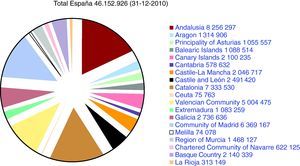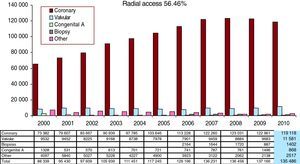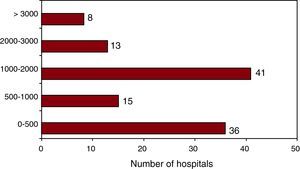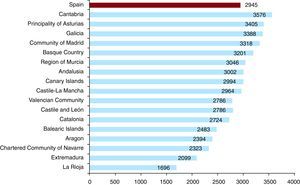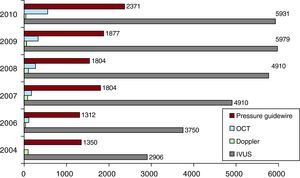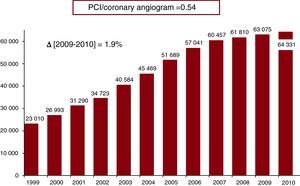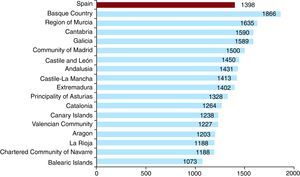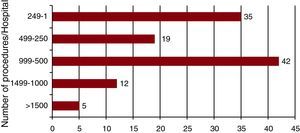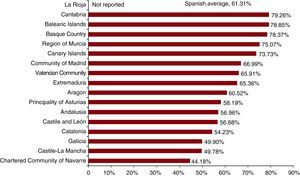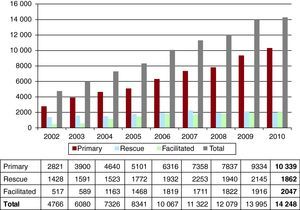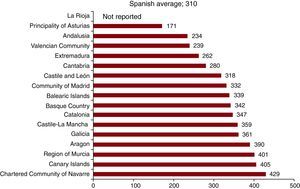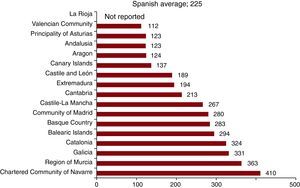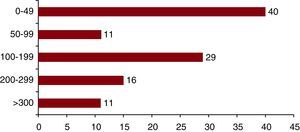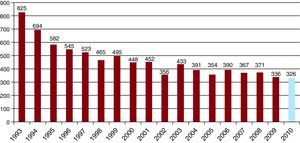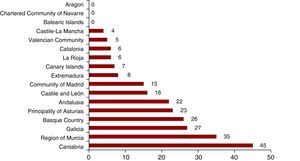The Working Group on Cardiac Catheterization and Interventional Cardiology presents on a yearly basis a report on the data collected for the national registry. This information displays how procedures are distributed throughout Spain and makes comparisons with other countries feasible.
MethodsInstitutions render their data voluntarily (online) and they are analyzed by the Working Group's steering committee.
ResultsData was sent by 113 hospitals (71 public and 41 private) that treat mainly adults, reporting 135 486 diagnostic procedures, 119118 of them coronary angiograms, slightly less than the year before, and with a rate of 2945 coronary angiograms per million inhabitants. Percutaneous coronary interventions increased a bit, to 64331 procedures and a rate of 1398 interventions per million. Of 100371 stents implanted, 61.3% were drug-eluting stents. In the acute phase of myocardial infarction, 14248 coronary interventions were carried out, 6% more than in 2009 and 22% of the total number of coronary interventions. The most frequent intervention for adult congenital heart disease was closure of an atrial septal defect (295 procedures). Percutaneous mitral valvuloplasty continues to decrease (326 procedures) and percutaneous aortic valve implantations are growing rapidly, with 655 units implanted in 2010.
ConclusionsThe greatest increase in activity has occurred in the field of myocardial infarction and percutaneous aortic valve implantation. The other procedures, both diagnostic and therapeutic, remain stable.
Keywords
.
INTRODUCTIONContinuing an annual tradition that has been maintained for 2 decades, one of the tasks of the Board of the Spanish Society of Cardiology Working Group on Cardiac Catheterization and Interventional Cardiology is to collect data on the activity of as many cardiac catheterization laboratories as possible in order to complete the Annual Registry of Activity. Data collection has steadily improved,1, 2, 3, 4, 5, 6, 7, 8, 9, 10, 11, 12, 13, 14, 15, 16, 17, 18, 19 mainly due to inputting the data online. For the first time, 100% of the hospitals provided their data, thus making the analysis more reliable. The data for 2010 were presented to the members of the Working Group at its annual meeting, which was held June 16-17 in Valencia. The data are also available from the Working Group's website (http://www.hemodinamica.com).
The quality of the information obtained offers an overview of the current situation in Spain and allows for comparisons with other countries. It also provides a way to assess and compare the development of interventional cardiology in Spain's autonomous regions. The free availability of these data is of great help in understanding how resources are distributed and in assessing the different trends in the use of diagnostic and therapeutic procedures.
In 2010, as in 2009, we continue to highlight 3 aspects of particular interest in the registry. First, interventional cardiology has reached a plateau with minimal growth. Secondly, the growth observed last year in percutaneous coronary intervention (PCI) procedures for myocardial infarction, and especially primary angioplasties, continues to increase. This may be due to different reasons, but has been particularly influenced by the European Stent 4 Life initiative20 which aims to improve the treatment of infarction, with Spain as one of their target countries.21 Several regions have joined this initiative this year, which has led to a significant increase in the number of primary PCIs. In fact, the increase in the number of infarct PCIs is the leading cause of the total increase in PCI. Finally, there is a continuing and marked increase in transcatheter aortic valve implantations (TAVI), both in the number of units implanted and the number of hospitals performing the technique. In addition, the Working Group has promoted the creation of a specific TAVI registry, whose preliminary data for 2010 were also presented to its members at the Valencia meeting.
This paper presents the 19th report on interventional activity in Spain and covers the activity of almost all public hospitals and much of the private sector.
METHODSWe collected data on diagnostic and interventional cardiovascular procedures in the majority of Spanish hospitals. Data collection was performed on a voluntary basis and was not audited. Each researcher was required to reassess the data if it was very inconsistent or if the values markedly differed from the trend in a given hospital in recent years. Data were collected using a standard electronic questionnaire accessed via the website of the Spanish Society of Cardiology Working Group on Cardiac Catheterization and Interventional Cardiology (http://www.hemodinamica.com) and was completed online. The data were analyzed by the Board of the Working Group in collaboration with the Persei company and are made public in this article.
Population-based calculations for Spain and each region were based on population estimates provided by the Spanish National Institute of Statistics for December 31, 2010, as published on its website (http://www.ine.es). The population of Spain at this time was 46152926 inhabitants (Figure 1). Note that for the first time, the procedures per million population for Spain were based on the total population, since in previous years these rates were calculated by averaging the different provinces where interventional cardiology was available, rather than by using the total population. Although the difference may be small in relation to previous years, it appears to better illustrate the current situation. As in previous registries, hospitals were defined as public regardless of their source of funding, providing they served a particular area of the population within the public health system; other hospitals were considered to be private.
Figure 1. Population of Spain as of December 31, 2010. Source: National Institute of Statistics.
RESULTS AND DISCUSSION Infrastructure and ResourcesA total of 113 hospitals performing interventional procedures in adults participated in the present registry (13 less than the previous year), and of these hospitals 10 also performed these procedures in pediatric patients (Appendix 1). In total, 71 of 74 public hospitals and 42 of 114 private hospitals submitted their data, 10 fewer private hospitals than in 2009 but nearly all the public hospitals that perform interventional procedures in Spain. There were 175 cardiac catheterization laboratories, of which 112 (64%) were in public hospitals; 35 hospitals had 2 laboratories and 7 hospitals had 3 or more. A 24-hour emergency team was available in 68% of the hospitals and 69% performed cardiac surgery.
Regarding personnel, 113 hospitals reported having 441 physicians who performed interventional procedures in 2010 (342 of whom were accredited). In public hospitals (323 physicians), there were 4.5 physicians per hospital and 2.8 per cardiac catheterization laboratory; in private hospitals there were 1.8 physicians per hospital and 1.8 per laboratory. In total, 113 hospitals provided data on their nursing staff. There were 544 registered nurses and 98 radiology technicians, with an average of 3.8 registered nurses or radiology technicians per public hospital and 3.3 per private hospital.
Diagnostic ProceduresDuring 2010, 135486 diagnostic procedures were performed, which is the first time there has been a decrease (1.2%) compared to the previous year. In total, 119918 coronary angiograms were performed, which was 3.2% fewer than in 2009 (the fact that 3 public hospitals and 10 private hospitals did not report these data as compared to the previous year may have influenced this result). Of these procedures, 24.9% were performed in women and 23% in patients older than 75 years, similar to the figures of last year. The national average was 2945 procedures per million population, taking into account the change in the way the averages were calculated, referred to above, representing an increase compared to 2009. This is still well below the most recent European average for 2005 of 4030 coronary angiograms per million population,22 or the latest data presented at the 2011 EuroPCR Congress of an average of more than 5500 coronary angiograms per million population in 2009.23 Of note is the 19.6% increase in the number of valve procedures, which is probably due to the increased number of TAVIs.
Figure 2 shows the distribution of all diagnostic procedures since 2000. In total, 62 hospitals performed more than 1000 coronary angiograms (7 more than in 2009), of which 21 performed more than 2000 (Figure 3). There was an average of 1198 diagnostic procedures per hospital (774 per laboratory), which was virtually unchanged from previous registries.18, 19 It is noteworthy that only 13 public hospitals (4 less than in 2009) performed fewer than 1000 coronary angiograms.
Figure 2. Evolution of the number and type of diagnostic procedures performed between 2000 and 2010.
Figure 3. Distribution of hospitals according to the number of coronary angiograms.
As mentioned, the national average was 2945 coronary angiograms per million population. Their distribution by region is shown in Figure 4. Compared to the previous year, the difference between the region performing the most coronary angiograms and the region performing the least was 1880.
Figure 4. Distribution of coronary angiograms per million population and region.
Regarding intracoronary diagnostic techniques, the situation is similar to the previous year. Intravascular ultrasound (IVUS) was the most frequently used technique, followed by pressure guidewire. There was a slight reduction (0.8%) in the use of IVUS, whereas the use of pressure guidewire increased by 26.6% (its use had already increased by 17% last year). The use of optical coherence tomography increased considerably, from 327 cases in 2009 to 557 in 2010, whereas the use of intracoronary Doppler guidewire continued to decrease, with just 43 cases as compared to the 52 cases in 2009. Figure 5 shows the evolution of different intracoronary diagnostic techniques in recent years.
Figure 5. Evolution of intracoronary diagnostic techniques. IVUS, intravascular ultrasound; OCT, optical coherence tomography.
Regarding access routes, use of the radial artery continued to increase, as in previous years, and finally surpassed the use of the femoral artery. The radial artery was used in 56.5% of cases compared to 45% in 2009 (Figure 1).
Coronary InterventionAll the hospitals that perform diagnostic procedures also perform PCI. Despite the reduction in coronary angiograms, the number of perform PCIs again increased slightly (1.9%), which was almost identical to the previous year (2%), with the current number standing at 64331. The historical development of PCI is shown in Figure 6. The number of PCIs per million population was 1398 (compared to 1391 in 2009), but still far below the latest European figures, with a rate of in 1601 PCIs per million population in 2005,22 or nearly 2000 per million population in 2009.23 This places Spain last in Europe.
Figure 6. Evolution of the number of percutaneous coronary interventions performed between 1999 and 2010. PCI, percutaneous coronary intervention.
The ratio of PCIs to coronary angiograms grew by 3% and now stands at 0.5. The number of procedures for multivessel disease remained very stable compared to the previous year and represented 25.4% of all PCIs. The frequency of ad hoc procedures performed during diagnosis also remained stable at 77% (this stood at 76% a year before).
The distribution by sex and age was very similar to that of 2009 with 20.2% of PCIs performed in women (1% more than the previous year), and 23.3% of procedures performed in patients over 75 years of age (identical to the previous year). Restenosis was treated by PCI in 5.3% of cases (5.6% in 2009). The number of interventions for restenotic lesions remained relatively stable, which may be explained by the fact that a similar number of drug-eluting stents (DES) has been used in recent years.
The significant increase in PCIs for unprotected left main coronary artery disease continued, now standing at 2271 interventions. This was 15% more than last year, representing 3.5% of all PCIs (3.1% in 2009). There were 994 and 184 interventions, respectively, on the saphenous vein and mammary artery.
Glycoprotein IIb/IIIa inhibitors and adjunctive antithrombotic drug therapy was used in 13869 procedures, representing 21.5% of PCI (very similar numbers to 2009): 62.7% with abciximab, 9.1% with tirofiban, 6.2% with eptifibatide and 22% with bivalirudin, whose use continued to increase compared to previous years.
Figure 7 shows the distribution by Spanish region of the 1398 PCIs per million population. The rate was slightly less than in 2009, decreasing from 836 to 793. Figure 8 shows the distribution per hospital, with 54 hospitals performing fewer than 500 PCIs per year (47%), although the majority of private hospitals were in this category; as in 2009, there were 17 hospitals in the high-volume (>1000) category.
Figure 7. Distribution of percutaneous coronary interventions per million population and region.
Figure 8. Distribution of hospitals according to the number of percutaneous coronary interventions performed in 2010.
Intracoronary diagnostic techniques (IVUS and pressure guidewire), which are mainly used to assess the severity of intermediate lesions or the outcome of the intervention, were similar in number to 2009, with IVUS and pressure guidewire representing 9.2% and 3.7% (more than 1% growth), respectively, of total PCIs.
Radial access in PCI (48.4%) grew by 3% and this was almost the same as femoral access. Regarding femoral access, vascular closure was used in 37064 cases, and for the first time underwent a decrease, of 9%. Collagen was used in 68% of these procedures, suture in 14.3%, and other types of device in 17.3%.
StentsStents were implanted in 96.5% of all PCIs (2% more than in 2009), with a total of 62046 units used in 100371 procedures in 2010 (3500 units less than in 2009). Again, the ratio of stents per patient decreased to 1.6 (1.6 in 2009); this could be related to the increase in angioplasty in myocardial infarction, where the ratio of stents per procedure is usually lower than in elective surgery. The use of DES increased by 1.8% compared to 2009 and stood at 61.3%, representing 61535 units. Since the characteristics of the patients and target lesions varied considerably, either one or both types of stent were used. Specifically, the percentage of procedures in which DES alone were used was 37.3%, which was a similar number to that of 2009 (33.6%) but almost 20% less than in 2008.
The use of DES continued to vary substantially between the Spanish regions, ranging from 79.3% in Cantabria to 44.2% in the Chartered Community of Navarre (Figure 9).
Figure 9. Distribution of antiproliferative drug-eluting stents as a percentage of all stents implanted by region.
Other Devices and Percutaneous Coronary Intervention ProceduresThe use of rotational atherectomy continued to grow (14.11%) compared to 2009, standing at 1213 procedures. The use of directional atherectomy or intracoronary brachytherapy was not reported. Among other devices, the use of cutting balloons continued to grow, with 2092 procedures in 2010. This was 17% more than in 2009 and 50% more than in 2008, reflecting an increase in the complexity of the cases. This is also indicated by the increased use of rotational atherectomy. Thrombectomy catheters were used in 7032 cases in 2010 compared to the 5481 in 2009, similar to the increase in infarct PCIs.
Intervention in Acute Myocardial InfarctionThe 14248 PCIs performed in acute myocardial infarction (AMI) represent a 6% increase compared to 2009, which was 10% higher than 2008, and constituted 22% of all PCIs (Figure 10). Of the total number of procedures, 22.3% were performed in women (5% more than in 2009) and 23.6% in patients aged more than 75 years, which was 2% more than last year.
Figure 10. Evolution of the types of percutaneous coronary intervention in acute myocardial infarction.
Within the range of PCI procedures performed in the acute phase of AMI, primary angioplasty continued to increase and was the fastest growing approach, increasing from 9334 in 2009 to 10339 in 2010 (a 10% increase compared to 2009 and a 29% increase compared to 2008). Four regions experienced marked growth in this regard: Principality of Asturias, Castilla-La Mancha, Catalonia, and Region of Murcia. Primary PCI accounted for 16% of angioplasties and 72.7% of all infarct PCIs; 2047 (14.4%) were facilitated PCI and 1862 (13%) were rescue PCIs, which decreased by 300 procedures compared to 2009 (Figure 10). There are no national data available on the number of ST-segment elevation AMI, but given the annual estimate for Spain of 45000 AMI,24, 25 then primary PCI would be used in just 20% of cases, despite the target of the Stent 4 Life initiative of 70% of primary PCIs in AMI.20
The national distribution of PCI in AMI shows a similar distribution to that of 2008, whereby those communities with an organized continuous care program for AMI had the best data (Figure 11, Figure 12).
Figure 11. Distribution of percutaneous interventions in acute myocardial infarction per million population and region.
Figure 12. Distribution of primary angioplasties per million population and region.
Regarding the number of procedures per center, 27 performed more than 200 infarct PCIs per year (4 more than in 2009), whereas 40 performed fewer than 50 (5 less than the previous year; see Figure 13).
Figure 13. Distribution of hospitals according to the number of percutaneous coronary interventions in acute myocardial infarction.
Noncoronary Interventions in AdultsMitral valve replacement remained the most frequent noncoronary intervention (324 cases), despite the slow but steady yearly decrease (Figure 14). The technique was performed in 59 of the 113 hospitals. Aortic valve replacement doubled in 2 years, increasing from 75 in 2008 to 146 in 2010. The growth in TAVI remained spectacular, increasing from 426 in 2009 to 655 in 2010 (39 hospitals performed the technique). Of these, 51% of the devices were self-expanding (94.4% successful; hospital mortality 5.6%) and 49% were balloon-expandable devices (92.1% successful; hospital mortality 7.9%). Figure 15 shows the distribution by region.
Figure 14. Evolution of mitral valve replacements in Spain.
Figure 15. Distribution of percutaneous aortic valve implantation by region (units per million population).
The treatment of adult congenital heart disease remained the most common noncoronary intervention procedure. In total, 682 procedures were performed (compared to 731 in 2009) and the most common of these was atrial septal defect (ASD) closure, with a total of 295 cases (329 in 2009) and a 96% success rate. There were major complications in 1.6% of cases and another 1.6% were classified as failures without complications. Foramen ovale closure was performed in 265 cases (232 in 2009) with a 99% success rate and only 1 major complication. Aortic coarctation was performed in 47 cases (10 more than last year). Other procedures included the closure of ductus, ventricular septal defects, and fistula.
In total, 114 paravalvular leaks were treated, 20 more than in 2008, of which 27 were mitral and 87 aortic.
Interventions in Pediatric PatientsIn total, 10 hospitals provided data on their activity in pediatric patients (16 years old or younger). These included 60 ASD closures and 93 ductus closures as the most common procedures.
CONCLUSIONSThe 2010 registry shows that the plateau or slight decrease in the development of diagnostic and therapeutic procedures has not changed. Angioplasty in the setting of AMI continues to grow, particularly that of primary PCI, probably due to the incorporation of new regions into primary PCI programs and the marked increase in the number of primary PCI performed in some hospitals. The Stent 4 Life program, which is a priority for the European Society of Cardiology, the Spanish Society of Cardiology, and our own working group, should serve to improve myocardial infarction care in Spain by raising awareness among policy makers, management, and medical professionals.
In general, differences remain between Spanish regions in the use of PCI, and specifically in its use for myocardial infarction.
The use of DES has remained stable in recent years, with considerable variation between regions and a distribution similar to that of previous years. The use of rotational atherectomy and cutting balloons increased considerably—possibly due to the cases becoming more complex—as well as the use of thrombectomy catheters due to increased infarct PCIs.
Radial access was used in more than 50% of cases for diagnosis and approached the same percentage in procedures.
Special reference should be made to TAVI, which grew by 50% compared to 2009. Despite its elevated cost, its spectacular growth remains unabated given that 39 hospitals performed TAVI procedures.
CONFLICTS OF INTERESTNone declared.
Acknowledgements
The Board of the Working Group on Cardiac Catheterization and Interventional Cardiology would like to thank the directors and staff of Spain's catheterization laboratories, as well as those responsible for data collection, for all their work which made this registry possible.
Appendix 1. Hospitals Participating in the 2010 Registry| Public hospitals | Private hospitals |
| Andalusia | |
| Complejo Hospitalario Torrecárdenas | Clínica El Ángel |
| Complejo Hospitalario Universitario de Jaén | Clínica Nuestra Señora de la Salud, Cádiz |
| Complejo Universitario Carlos Haya | Clínica Parque San Antonio |
| Hospital Clínico Universitario Virgen de la Victoria | Hospital USP de Marbella |
| Hospital Costa del Sol | Hospiten Estepona |
| Hospital de Jerez de la Frontera | |
| Hospital Juan Ramón Jiménez | |
| Hospital Universitario de Valme | |
| Hospital Universitario Puerta del Mar | |
| Hospital Universitario Puerto Real (Cádiz) | |
| Hospital Universitario Reina Sofía | |
| Hospital Universitario Virgen de las Nieves | |
| Hospital Universitario Virgen del Rocío | |
| Hospital Universitario Virgen Macarena | |
| Aragon | |
| Hospital Clínico Universitario Lozano Blesa, Zaragoza | |
| Hospital Universitario Miguel Servet, Zaragoza | |
| Principality of Asturias | |
| Hospital Central de Asturias | Centro Médico de Asturias |
| Cantabria | |
| Hospital Universitario Marqués de Valdecilla | |
| Castile and León | |
| Hospital Clínico Universitario de Salamanca | Hospital Campo Grande (CEMIN) |
| Hospital Clínico Universitario de Valladolid | |
| Hospital de León | |
| Hospital General Yagüe | |
| Castile-La Mancha | |
| Hospital General de Ciudad Real | |
| Hospital General Universitario de Albacete | |
| Hospital General Universitario de Guadalajara | |
| Hospital Virgen de la Salud | |
| Catalonia | |
| Ciutat Sanitària i Universitària de Bellvitge | Centre Cardiovascular Sant Jordi |
| Hospital Clínic i Provincial de Barcelona | Hospital de Barcelona SCIAS |
| Hospital de la Santa Creu i Sant Pau | Hospital General de Catalunya |
| Hospital del Mar, Barcelona | Hospital Universitari Sagrat Cor (ANGIOCOR, S.L.) |
| Hospital General Universitari Vall d’Hebron | Hospital Universitari Mútua de Terrassa |
| Hospital Universitari Dr. Josep Trueta | |
| Hospital Universitari Germans Trias i Pujol | |
| Hospital Universitari Joan XXIII | |
| Hospital Universitario Arnau de Vilanova de Lleida | |
| Valencian Community | |
| Hospital Clínico Universitario de Valencia | Clínica Medimar Alicante |
| Hospital de la Ribera (Alzira) | Hospital 9 de Octubre de Valencia |
| Hospital General de Alicante | Hospital Clínica Benidorm |
| Hospital General de Castellón | Hospital del Vinalopó |
| Hospital General Universitario de Elche | Hospital Levante Benidorm |
| Hospital General Universitario de Valencia | Hospital Perpetuo Socorro, Alicante |
| Hospital Universitario Dr. Peset | Hospital San Jaime Torrevieja USP |
| Hospital Universitario La Fe | UTE Torrevieja Salud |
| Hospital Universitario San Juan de Alicante | |
| Extremadura | |
| Hospital de Cáceres | |
| Hospital Universitario Infanta Cristina | |
| Galicia | |
| Complexo Hospitalario Universitario de A Coruña | Instituto Médico Quirúrgico San Rafael |
| Complexo Hospitalario Universitario de Santiago | |
| Complexo Hospitalario Universitario de Vigo | |
| Balearic Islands | |
| Hospital Universitario Son Dureta | Clínica Juaneda |
| Clínica Rotger | |
| Clínica USP Palmaplanas | |
| Policlínica Miramar | |
| Canary Islands | |
| Hospital de Gran Canaria Dr. Negrín | |
| Hospital Universitario de Canarias, Tenerife | |
| Hospital Universitario Insular de Gran Canaria | |
| Hospital Universitario Ntra. Sra. de Candelaria | |
| Hospiten Rambla | |
| Community of Madrid | |
| Hospital Central de la Defensa Gómez Ulla | Clínica La Luz |
| Hospital Clínico San Carlos | Clínica Moncloa, Madrid |
| Hospital General Universitario Gregorio Marañón | Clínica Nuestra Señora de América |
| Hospital Puerta de Hierro | Clínica Ruber |
| Hospital Ramón y Cajal | Fundación Jiménez Díaz |
| Hospital Universitario 12 de Octubre | Hospital La Moraleja (Sanitas) |
| Hospital Universitario de La Princesa | Hospital La Zarzuela |
| Hospital Universitario Fundación Alcorcón | Hospital Universitario Quirón Madrid |
| Hospital Universitario La Paz | Hospitales de Madrid Montepríncipe y Sanchinarro |
| Sanatorio del Rosario de Madrid | |
| Sanatorio La Milagrosa | |
| Sanatorio San Francisco de Asís | |
| Region of Murcia | |
| Hospital Universitario Santa María del Rosell | Hospital San Carlos, Murcia |
| Hospital Universitario Virgen de la Arrixaca | Hospital Virgen de la Vega, Murcia |
| Chartered Community of Navarre | |
| Hospital de Navarra | |
| Basque Country | |
| Hospital de Basurto - Basurtuko Ospitalea | Clínica Vicente San Sebastián |
| Hospital de Cruces | Policlínica Guipúzcoa |
| Hospital de Galdakao-Usansolo | |
| Hospital Txagorritxu | |
| La Rioja | |
| Hospital Viamed-Los Manzanos |
Received 21 July 2011
Accepted 3 August 2011
Corresponding author: Unidad de Hemodinámica, Hospital Juan Ramón Jiménez, Ronda Norte s/n, 21005 Huelva, Spain. JFDIAZF@telefonica.net
